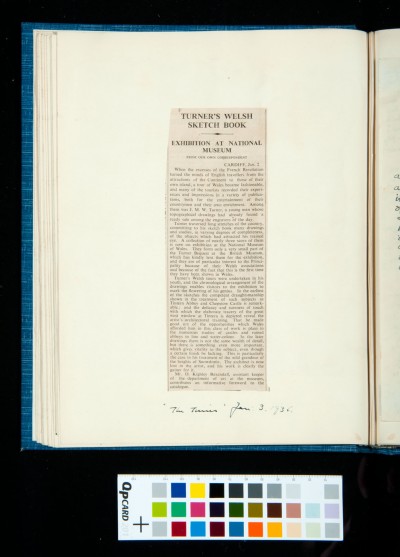Cotmania. Vol. XI. 1935-6
Archive: SDK Sydney Decimus Kitson Archive
Reference Number: SDK/1/2/1/11
Page: 14 verso
-
Description
Newspaper article about Turner's sketchbook in The Times, 3 January 1936
Date:
-
Transcription
TURNER'S WELSH SKETCH BOOK
---------
EXHIBITION AT NATIONAL MUSEUM
From our own correspondent
Cardiff, Jan. 2When the excess of the French Revolution turned the minds of English travellers from the attractions of the attractions of the continent to those of their own island, a tour of Wales became fashionable, and many of the tourists recorded their experiences and impressions in a variety of publications, both for the entertainment of their countrymen and their own enjoyment. Among them was J M W Turner, a young man whose topographical drawings had already found a ready sale among engravers of the day.
Turner traversed long stretches of the country, committing to his sketchbook many drawings and studies, in varying degrees of completeness, of the objects which had attracted his trained eye. A collection of nearly three score of them is now on exhibition at the National Museum of Wales. They form only a very small part of the Turner Bequest at the British Museum, which has kindly lent them for the exhibition, and they are of particular interest to the Principality because of their Welsh associations and because of the fact that this is the first time they have been shown in Wales.
Turner's Welsh tours were undertaken in his youth, and the chronological arrangement of the drawings enables visitors to the exhibition to mark the flowering of his genius. In the earliest of the sketches the competent draughtsmanship shown in the treatment of such subjects as Tintern Abbey and Chepstow Castle is remarkable; and the delicacy and sureness of touch with which the elaborate tracery of the great west window at Tintern is depicted reveal the artist's architectural training. That he made good use of the opportunities which Wales afforded him in this class of work is plain in the numerous studies of castles and ruined abbeys in line and water-colour. In the later drawings there is not the same wealth of detail, but there is something even more important, which gives vitality to the subject, even though a certain finish be lacking. This is particularly the case in his treatment of the wild grandeur if the heights of Snowdonia. The architect is now lost in the artist, and his work is clearly the gainer for it.
Mr D Kighley Baxandall, assistant keeper of the department of art at the museum, contributes an informative foreword to the catalogue.'The Times' Jan: 3, 1936.
